I made an AVFoundation camera to crop square images based on @fsaint answer: Cropping AVCaptureVideoPreviewLayer output to a square . The sizing of the photo is great, that works perfectly. However the image quality is noticeably degraded (See Below: first image is preview layer showing good resolution, second is the degraded image that was captured). It definitely has to do with what happens in processImage: as the image resolution is fine without it, just not the right aspect ratio. The documentation on image processing is pretty bare, any insights are GREATLY appreciated!!
Setting up camera:
func setUpCamera() {
captureSession = AVCaptureSession()
captureSession!.sessionPreset = AVCaptureSessionPresetPhoto
let backCamera = AVCaptureDevice.defaultDeviceWithMediaType(AVMediaTypeVideo)
if ((backCamera?.hasFlash) != nil) {
do {
try backCamera.lockForConfiguration()
backCamera.flashMode = AVCaptureFlashMode.Auto
backCamera.unlockForConfiguration()
} catch {
// error handling
}
}
var error: NSError?
var input: AVCaptureDeviceInput!
do {
input = try AVCaptureDeviceInput(device: backCamera)
} catch let error1 as NSError {
error = error1
input = nil
}
if error == nil && captureSession!.canAddInput(input) {
captureSession!.addInput(input)
stillImageOutput = AVCaptureStillImageOutput()
stillImageOutput!.outputSettings = [AVVideoCodecKey: AVVideoCodecJPEG]
if captureSession!.canAddOutput(stillImageOutput) {
captureSession!.sessionPreset = AVCaptureSessionPresetHigh;
captureSession!.addOutput(stillImageOutput)
previewLayer = AVCaptureVideoPreviewLayer(session: captureSession)
previewLayer!.videoGravity = AVLayerVideoGravityResizeAspectFill
previewLayer!.connection?.videoOrientation = AVCaptureVideoOrientation.Portrait
previewVideoView.layer.addSublayer(previewLayer!)
captureSession!.startRunning()
}
}
}
Snapping photo:
@IBAction func onSnapPhotoButtonPressed(sender: UIButton) {
if let videoConnection = self.stillImageOutput!.connectionWithMediaType(AVMediaTypeVideo) {
videoConnection.videoOrientation = AVCaptureVideoOrientation.Portrait
self.stillImageOutput?.captureStillImageAsynchronouslyFromConnection(videoConnection, completionHandler: {(sampleBuffer, error) in
if (sampleBuffer != nil) {
let imageData = AVCaptureStillImageOutput.jpegStillImageNSDataRepresentation(sampleBuffer)
let dataProvider = CGDataProviderCreateWithCFData(imageData)
let cgImageRef = CGImageCreateWithJPEGDataProvider(dataProvider, nil, true, CGColorRenderingIntent.RenderingIntentDefault)
let image = UIImage(CGImage: cgImageRef!, scale: 1.0, orientation: UIImageOrientation.Right)
self.processImage(image)
self.clearPhotoButton.hidden = false
self.nextButton.hidden = false
self.view.bringSubviewToFront(self.imageView)
}
})
}
}
Process image to square:
func processImage(image:UIImage) {
let deviceScreen = previewLayer?.bounds
let width:CGFloat = (deviceScreen?.size.width)!
UIGraphicsBeginImageContext(CGSizeMake(width, width))
let aspectRatio:CGFloat = image.size.height * width / image.size.width
image.drawInRect(CGRectMake(0, -(aspectRatio - width) / 2.0, width, aspectRatio))
let smallImage = UIGraphicsGetImageFromCurrentImageContext()
UIGraphicsEndImageContext()
let cropRect = CGRectMake(0, 0, width, width)
let imageRef:CGImageRef = CGImageCreateWithImageInRect(smallImage.CGImage, cropRect)!
imageView.image = UIImage(CGImage: imageRef)
}

